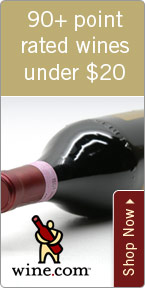A FEW Tips On Tasting Fine Wines

Wednesday - May 09, 2007
| Share
 Del.icio.us
Del.icio.usThis is not an infomercial. But do you want to know how to make yourself a better wine taster? Are you tired of trying to explain what kind of wine you would like to drink to a waiter, sommelier or salesperson and just getting the “deer in the headlights” look? Do you want to avoid the embarrassment and awkwardness of ordering a nice bottle of wine for your date, spouse or boss?
In the world today, as wine becomes the most important “adult” beverage, it is becoming more important to be conversant in wine. So here are some personal tips to make you a better wine lover.
The hardest thing to do in wine tasting is not the tasting itself. We all have a sense of smell and can taste things. It’s not a level playing field. Some tasters are better than others. But you know what your favorite flavor of ice cream is or your favorite dish at your favorite restaurant. You’ve been able to avoid the spoiled milk and have thrown out the spoiled rice.
So you can taste. But what is harder than that is to take all the information your senses are transmitting to your brain and then literally “spitting them out” in words.
As with any other subject, learning the vocabulary is one of the first steps to being able to understand and express wine. Lucky for us, wine vocabulary is much like vocabulary we all use every day. Just remember a FEW things.
FEW is an acronym that I like to use for helping people remember how to describe wines.
F stands for fruit and flowers. Wine is made from fruit (grapes) - duh! But somehow during the fermentation process, the chemical components produce aromatics akin to other types of fruit: cherries, blackberries, blueberries, strawberries, cranberries, orange, apple, lemon, lime, pear, lychee, melon, papaya, etc. Some wines can even smell like flowers: plumeria, puakenikeni, pikake, lilies, violets, orange and lime blossoms ... the list goes on.
E stands for earth. The vines are grown in the ground (still) and they sometimes express that same earthy character: wet stone, chalk, slate and more. Things like mushroom, forest floor or vegetation can also be an earthy character.
W stands for wood. Much fine wine is aged in wood - oak, to be exact. Oak can impart vanilla, cedar, toasty, cinnamon, cardamom, nutmeg, dill and even coconut aromas into a wine.
Another tip is to become an avid smeller. Be aware of the aromas around you. Whenever I go to open markets or choose fruit, I always smell them. An old farmer once told me about picking ripe fruit at a store, that if you can smell the fruit, you’ll be able to taste it. You’ll see me in Home Depot smelling the herbs and maybe even a two-by-four!
You’ll become familiar with terms like body, tannin, alcohol, acidity as you taste more and more wine. For these characters, really take your time in tasting the wine. Don’t just chug it down. Feel the way the wine interacts with your mouth and where. The weight, stringency and warmth are different for each wine.
Lastly, practice talking about wine. Take a wine class (I teach one). Go to wine tastings and presentations to hear how others describe wines. Read a wine magazine or critic’s column to see how the “experts” do it. And don’t be afraid. Not everyone can speak foreign languages fluently. Master sommeliers butcher names just as badly as anyone who doesn’t know anything about wine. You will enjoy wine even more as your senses are heightened - and isn’t that really what it’s all about?
2005 A&P de Villaine Bourgogne Blanc ‘Les Clous’ - $28 from a great producer and great vintage, this Chardonnay from France is seamless and delicious.
WinED is a monthly wine tasting at Formaggio’s Wine Bar taught by yours truly. If you would like to learn more about it, please e-mail me at .(JavaScript must be enabled to view this email address)
Roberto Viernes is a master sommelier. E-mail .(JavaScript must be enabled to view this email address)E-mail this story | Print this page | Comments (0) | Archive | RSS Comments (0) |
Most Recent Comment(s):












